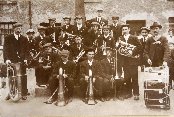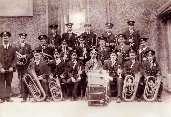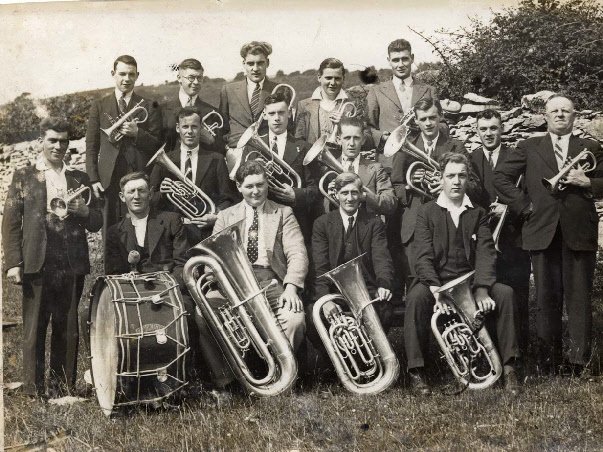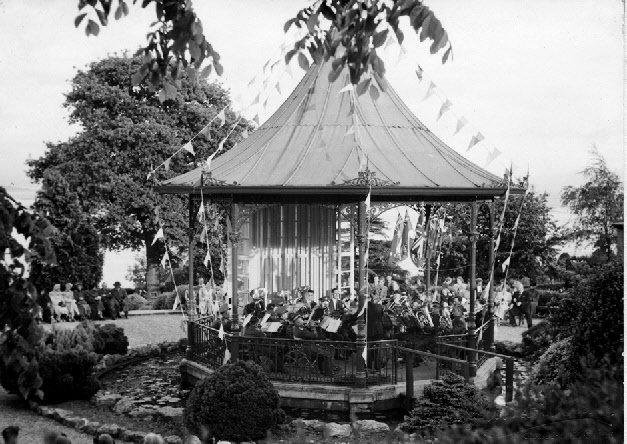

A Brief History of Flookburgh Band
History the 1960s Click Here - 1970s to Present Day Click here
Early Beginnings - 1909
The band has been a part of the social life of the village for ten decades at the time of writing. Since its inception it is estimated that more than 150 local people, mostly men but also some girls in the last few years have played in the band. This is an attempt to gather together some facts so that we may know how it was formed, some of the personnel involved, and incidents which have occurred along the way.
Minutes of a meeting held on the 4th of May 1909 state that:-
“It was resolved to form a club in connection with a band.”
“It was resolved that it be called the Flookburgh Village Hall Brass Band.”
“That no member be allowed to put less than 6d per night into the club.”
“That the first payment to start on the 8th of May 1909.”
“That no-one be allowed to enter the band unless he is a member of the Flookburgh Village Hall or intending to become one.”
“That anyone blowing an instrument in the street will be fined 2/6 or forfeit their instrument.”
“That each man pay 16/- before he is a full member.”
“That every member pay their 16/- before March 4th 1910”
Here had been set out the ground rules. click on all Image to see full size.
click on all Image to see full size.
A book of rules appeared in January 1912 and every member had to sign to say that they agreed to abide by them and also had to sign over a sixpenny stamp, an official receipt, on being given an instrument.
The first man to sign this book was Peter Butler who was a blacksmith and, later, caretaker and steward of the billiards room in the Village Hall for many years and indeed remained the caretaker until the demise of the billiards and snooker room in the 1950s. For over thirty years now it has been the bandroom.
The second man was John (Jack) Wilson who was the uncle of Edward Wilson of Sandgate Farm and the longest and only surviving member of the original band. In about 1980 it was arranged to have a photograph of him with the band in front of the Market Cross just as the first photograph of the band had been.
The next name in the book was Thomas Wilson who was the great-great grandfather of Thomas our present Repiano cornet player who is the third Thomas Wilson to be in the band out of a total of eight from that family who have played at different times and are the only family with an unbroken line from inception of the band to the present day. Ther have been Thomas senior, his son Harold (always called Ted), grandson John and great grandson Thomas. Three of Thomas the elder's sons played in the band; Tom, Ted and Bill but their names were really Thomas, Harold and Earnest. Roy who was born the son of Thomas No.2 played for 4 or five years but had a serious congenital heart problem and unfortunately died in the mid 1950s whilst still in his early 20s.
On the 4th of May 1909 thirty names were listed as joining and on that day 25 of those paid either 1/- or 6d and thereafter, weekly amounts varying from 6d to 4/-. Twenty-one men are subsequently shown to have paid their 16/- which made them full members. Each member then had to pay 3d per week into a practice fund. All the members were local men, a good percentage being fishermen. There were a few who were not players but served on the committee as President, Chairman, Secretary or Treasurer etc.
There is a documentary report of a concert given by the band in 1910 when; “Lord Richard Cavendish never flinched from his place on the platform even when it’s playing was most powerful.” Lord Richard was elected president on the 28th of August 1925.
It is recorded in an almanac for November 1909 that, “The members of Flookburgh band were most energetic, diligently practicing at all possible times and in all available places to the untold delight of the inhabitants -- some of whom would leave their warm cottages and gather outside The Hall to listen in silent admiration to the music of “Our Band.” We heard of one dear old lady who was almost moved to tears on the 14th when it was playing near Sandgate. She had never heard anything so beautiful before, it was nearly like Heaven.”
As you can see there is a complex web of family connections and
when it is added that in the list of 30 original members there are 4 Butlers, 4 Bensons, 4 Robinsons and 3 Burrows, it is obvious that the family connections could take some sorting out. Of those thirty, two, (who were fishermen) were drowned in a boating accident in 1912 and one emigrated to America
H.M.Manning is first mentioned in the minutes of a meeting on 18th of May 1925 but under his previous name of H. Butler when he seconded a proposition that the band offer their services to Holker Club for their fete in Holker Park. Harold played with the band for about forty-six years, several of those years as principal cornet and later as bandmaster.
Fred Benson who, at the time of writing, is the oldest surviving ex-player, was enrolled on the 4th of February 1929 along with others who are still living in the village, such as Fred Butler, Albert Butler (not related) and Cyril Wearing. Mr. Benson retired from playing in 1979 but was made a life-member and presented with a silver tray.
1937
The name Flookburgh Silver Band first appears in minutes dated 28th of December 1937 but the minutes of a meeting on the 31st of January read :- “Moved by J.Wright and seconded by W. Dickinson and carried,that the name of the band be changed from Flookburgh Village Hall Brass Band to Flookburgh Silver Band.”
The secretary then was Fred Metcalfe, Treasurer; G. Bowker, Chairman Joe Moyle and Bandmaster was J.Cropper.
Flookburgh Silver Band - Allithwaite Carnival June 23rd 1938 |
Back Row E. Wilson, W.J. Nickson, G.S. Bellas, J.L. Moyle, T.M.Robinson Middle H.M. Manning, T. Wilson, H. Wilson, H. Wilson, J.C. Davis, A. Couperthwaite, A. butler, S. Benson Front W. Stephenson, L.C. Stephenson, W. Dickinson, W. Dickinson, Junior |
October 18th 1938 “That 100 letters of appeal be sent out on behalf of the uniform fund.” The first new uniforms were ordered in 1939, therefore would only be worn once or twice before the war. On Tuesday the 7th of February 1939 a Mr. Evans of Beaver & Co. Ltd. came to a meeting in the Hope and Anchor Hotel to discuss styles and material etc. Arrangements were made for Mr. Evans to take measurements on Sunday February 29th. The uniforms chosen were a sort of Airforce Blue with red or perhaps nearer pink trimming, the tunics having a row of gold buttons down the front and high collars which fastened at the front with two hooks and eyes, as army uniforms were at that time. There was also a webbing type belt which had a 3” square gold plate with a gold button inset. On the back of the plate were again, two hooks with which to fasten the belt. After having written this, it was noticed that at a meeting on the 14th of February it was carried, “That the Airforce Material be chosen for the uniforms.” There was a special Bandmaster’s uniform and one for a boy, namely Jim Dickinson. After the war this boy’s uniform was inherited by Jack Manning and altered to fit him by the then chairman Mr. Joe Moyle and his wife and was proudly worn by him on his first engagement with the band on Remembrance Sunday 1946. There were many Whist Drive / Dances at which the admission was usually about 1/- for each of the events i.e. 1/- Whist drive and 1/- or sometimes 6d for the dance. On one occasion in October 1939 it was carried that; “The secretary order 100 paper hats and 1000 streamers for the dance. The band organized the catering for supper and the cost per person was ls:3d (61/2p). Raffle tickets for a cake and a bottle of port were 1d each (1/2p). |
|
Just before the war, the bandroom was a large room above the Hope and Anchor and indeed was so until about 1947 and we know it was only from 1939 because it is stated in a minute of February 2nd 1939 that; “Mr. Moyle and Mr. Cropper should interview Mr. T.Bailey (Landlord of the Hope & Anchor) with a view to obtaining full use of the bandroom.” It is assumed that the upper room of the Hope & Anchor had been used for some time but now it was the official bandroom. A minute of a meeting held in the bandroom at the Hope & Anchor on the 11th of February 1947 says that; “The present bandroom at the Hope & Anchor should be retained at the fee of 2/6 weekly”, although the school was used for the classes through the Education Authority while the old bandroom was still retained. Throughout the Second World War there was no band as most of the players were away in the various armed forces but as soon as they began to trickle back, in 1945, it was reformed. |
|
Band in First Uniforms - 1950sBack Row S.Bland, L.Moyle, J.Manning, R.Metcalfe, W.Nickson, J.Fogg, R.Butler, H.Garnett Middle J.Wright (chairman), J.Dickinson, W.Bland, Unknown (Barrow), H.Sutcliffe, C.Robinson, H.Wilson (Ted). Front F.Butler, M.Robinson, W.Dikinson, H.Manning, A.Cowperthwaite, F.Benson, T.Wilson, L.Stephenson. |
|
After the WarThe first meeting after the war was on July 25th 1946 but the band had been rehearsing, albeit with only about nine players, for some months or perhaps a year before that date. Joe Moyle was again elected chairman, Fred Benson secretary and bandmaster Septimus Benson. Mr. J.B. Smalley was elected President and Mrs. Smalley one of the vice presidents. The annual subscription was set at 2/6 for adults and 1/- for the under 16s. The principal cornet player from the time that the band was reformed was Sydney Bland, an excellent musician who remained in that position for about twenty years. For fifteen of those years the line-up of first comets was Sydney Bland, Jack Manning and Leslie Moyle, the latter being a hard working stalwart of the band and secretary for many years. Sydney had played with Arnside Band before the war and by the standards of the band at that time he was outstanding. Having said that, he would probably have made an excellent dance band trumpeter as he had a natural flair for free playing. He could double and triple tongue which was rare then and in fact only he and Bill Dickinson could do this. With the standard of music played now it is essential for all players, even Basses, to at least double tongue. Syd had a good ear and could busk well but was always terribly nervous at contests which he dreaded. After 1947 the infants’ school became the bandroom. The rehearsals were then run as night classes through the education system and Jack Jacobs came from Barrow as conductor and teacher. He started off with a class of about twenty boys out of which came three players, two of whom stayed for just a few years then after perhaps the mid-1950s only Jack Manning, who at the present time has been in the band for fifty years, remained. |
|
Grange Bandstand - Coronation Year 1953 |
|
Septimus BensonSeptimus Benson or Sep as he was always known, was a fisherman who was what would now be called “a character”, about whom many stories have been told. He was the principal cornet player before the war but did not play after it. He conducted for a while and started to teach a class of youngsters. Sep used to hang a cornet on a string from a beam and his pupils were expected to be able to produce notes from the instrument without touching it. This was to demonstrate that one did not need to use pressure on the lip to be able to play a brass instrument. |
|
There appears to have been difficulty about a bandroom around this time as there is mention of the possibility of a room at the Power Station (Flookburgh Farm, now called Stockdale Farm) and at the Station Hotel where the garage was vacant. There was also a proposition in January 1951 that the secretary should write to the council about permission to erect a hut on the bowling green. |
|
Bill DickinsonBill joined the band in 1930 and played for sixty three years which is a tremenous record. He started on cornet but soon moved to the euphonium where he remained for the rest of his years in the band and was the principle euphonium player for nearly sixty years, playing his last concert in May 1994, just three months before his death. He was an excellent musician with a superb tone and also a very modest gentlman. Although several euphonium players came along in his time, none could match his quality and thereby take his place as principle player. Bill was made a life member and a suprise celebration party to mark his sixty years as a player was held at the Armadale Hotel on Sunday the 18th of November 1990. He was also made a life member of C.B.B.A. in 1991. He died on the 9th of August 1994 and a memorial concert was held at the Grange Hotel from which £200 was raised for the charity, Leukaemia in Children. It was suggested that a trophy should be donated to Cumbria B.B.A. this was duly paid for and presented by his widow, Mrs. Elsie Dickinson and named The Bill Dickinson Memorial Trophy. His father had been a bass player and founder member of the band but died in 1939. Bill's brother Jim who played cornet and later tenor horn, was also secretary for a number of years and, for a while, bandmaster. Their uncle, Robert Howson, was a founder member and their cousin Lawrence Stephenson was a Bb Bass player for forty years. |
 |
History the 1960s Click Here - 1970s to Present Day Click here




